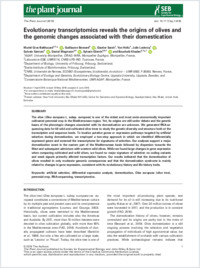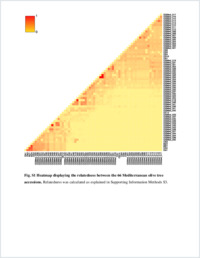Evolutionary transcriptomics reveals the origins of olives and the genomic changes associated with their domestication
- Gros-Balthazard, Muriel University Montpellier, France
- Besnard, Guillaume Laboratoire EDB, Toulouse, France
- Sarah, Gautier University Montpellier, France
- Holtz, Yan University Montpellier, France
- Leclercq, Julie University Montpellier, France
- Santoni, Sylvain University Montpellier, France
- Wegmann, Daniel Department of Biology, University of Fribourg, Switzerland - Swiss Institute of Bioinformatics, Fribourg, Switzerland
- Glémin, Sylvain CNRS, Université de Rennes, France, - Department of Ecology and Genetics, Evolutionary Biology Centre, Uppsala University, Sweden
- Khadari, Bouchaib University Montpellier, France - Conservatoire Botanique National Méditerranéen, Montpellier, France
-
11.07.2019
Published in:
- The Plant Journal. - 2019, p. tpj.14435
English
The olive (Olea europaea L. subsp. europaea) is one of the oldest and most socio‐ economically important cultivated perennial crop in the Mediterranean region. Yet, its origins are still under debate and the genetic bases of the phenotypic changes associated with its domestication are unknown. We generated RNA‐sequencing data for 68 wild and cultivated olive trees to study the genetic diversity and structure both at the transcription and sequence levels. To localize putative genes or expression pathways targeted by artificial selection during domestication, we employed a two‐ step approach in which we identified differentially expressed genes and screened the transcriptome for signatures of selection. Our analyses support a major domestication event in the eastern part of the Mediterranean basin followed by dispersion towards the West and subsequent admixture with western wild olives. While we found large changes in gene expression when comparing cultivated and wild olives, we found no major signature of selection on coding variants and weak signals primarily affected transcription factors. Our results indicated that the domestication of olives resulted in only moderate genomic consequences and that the domestication syndrome is mainly related to changes in gene expression, consistent with its evolutionary history and life history traits.
- Faculty
- Faculté des sciences et de médecine
- Department
- Département de Biologie
- Language
-
- English
- Classification
- Biological sciences
- License
-
License undefined
- Identifiers
-
- RERO DOC 326950
- DOI 10.1111/tpj.14435
- Persistent URL
- https://folia.unifr.ch/unifr/documents/308048
Other files
Statistics
Document views: 118
File downloads:
- pdf: 231
- Supplementary material: 147

